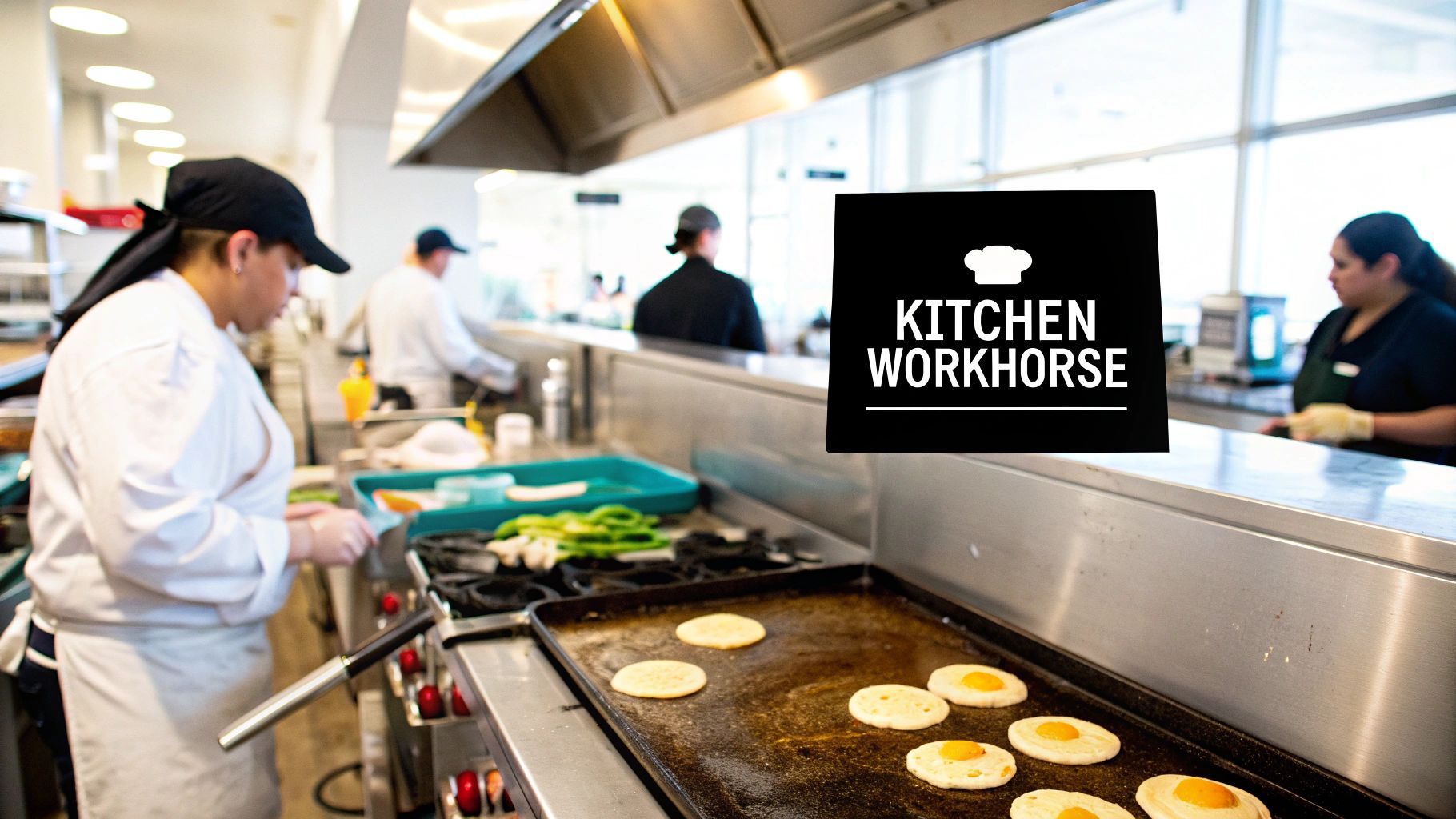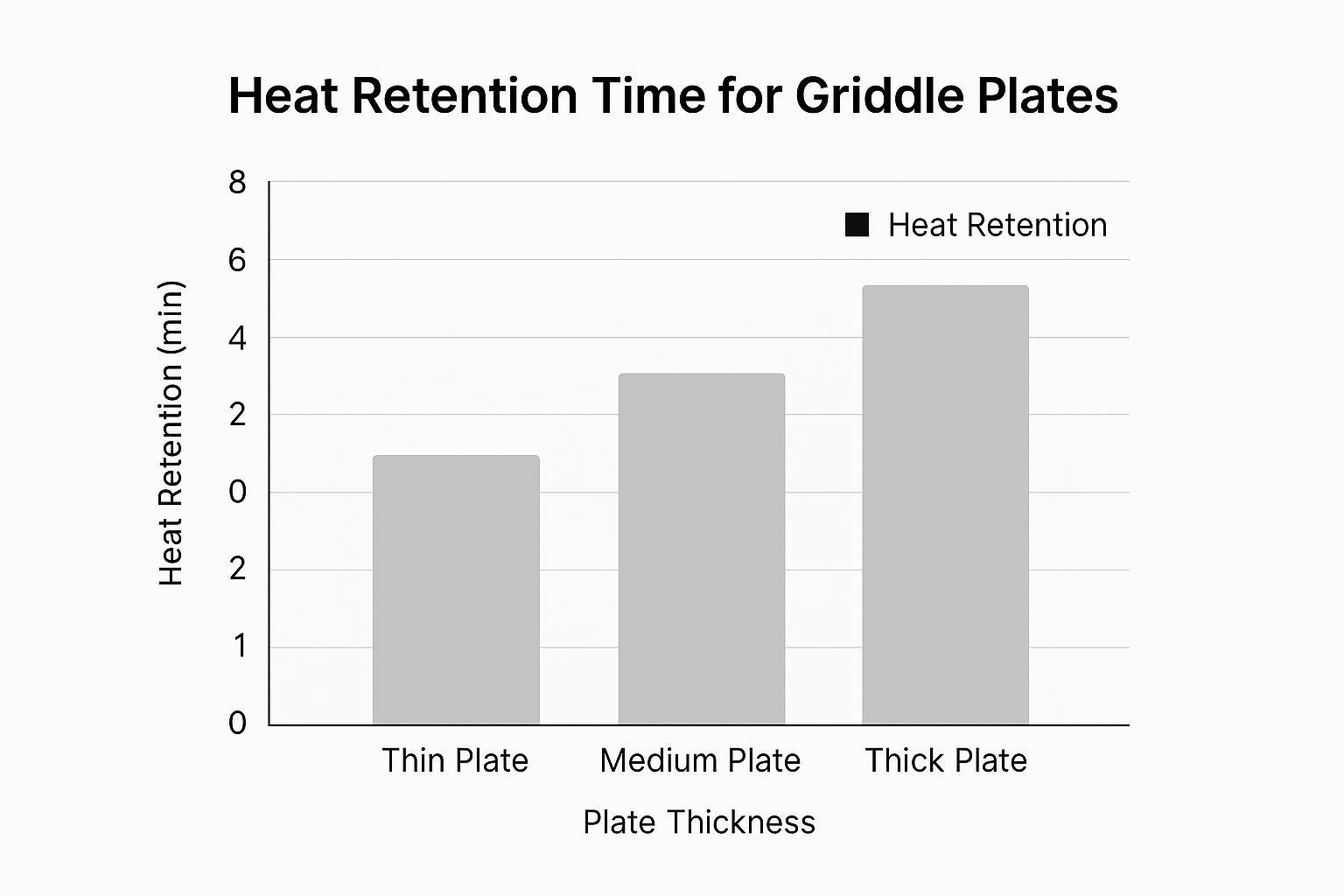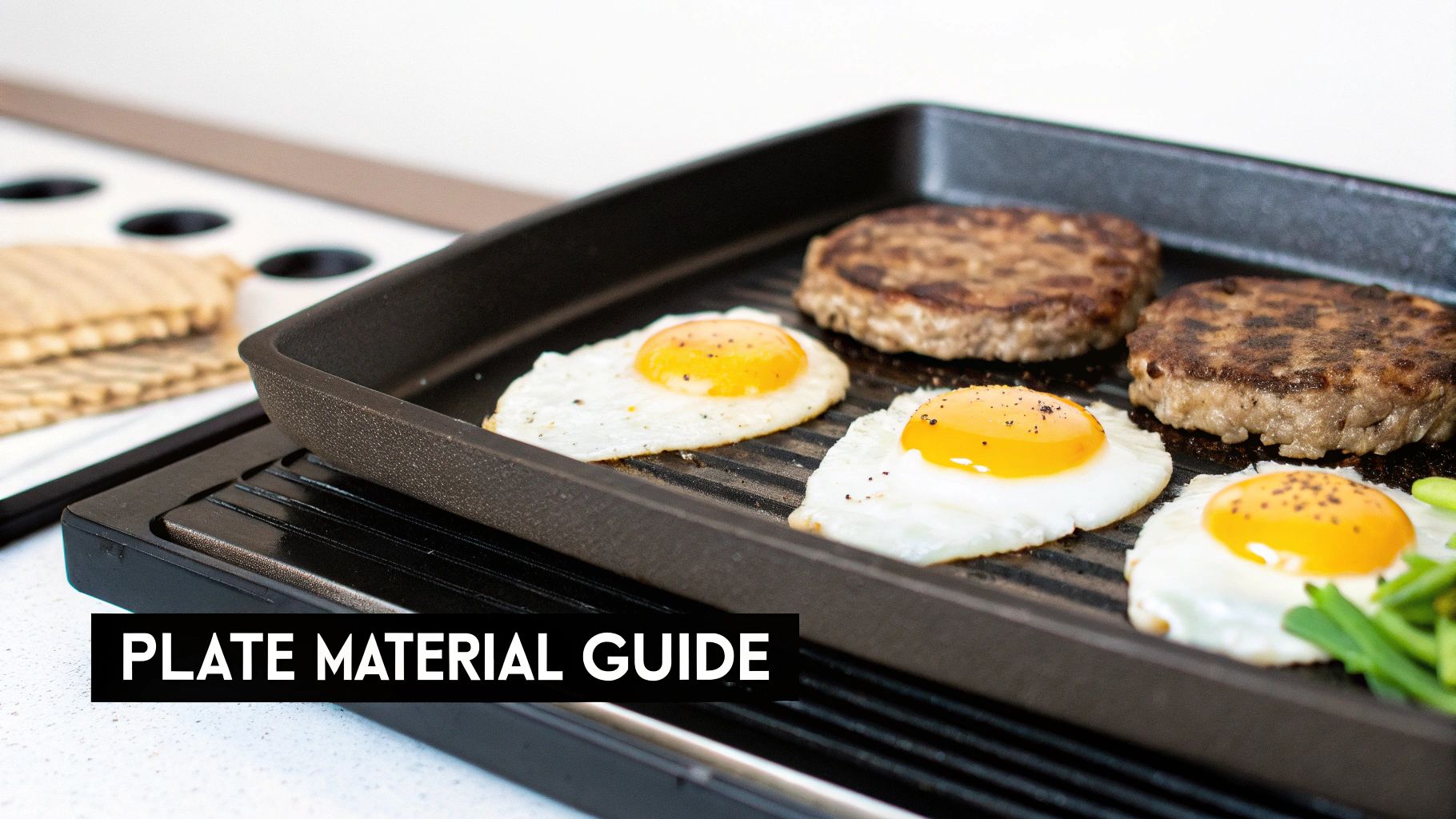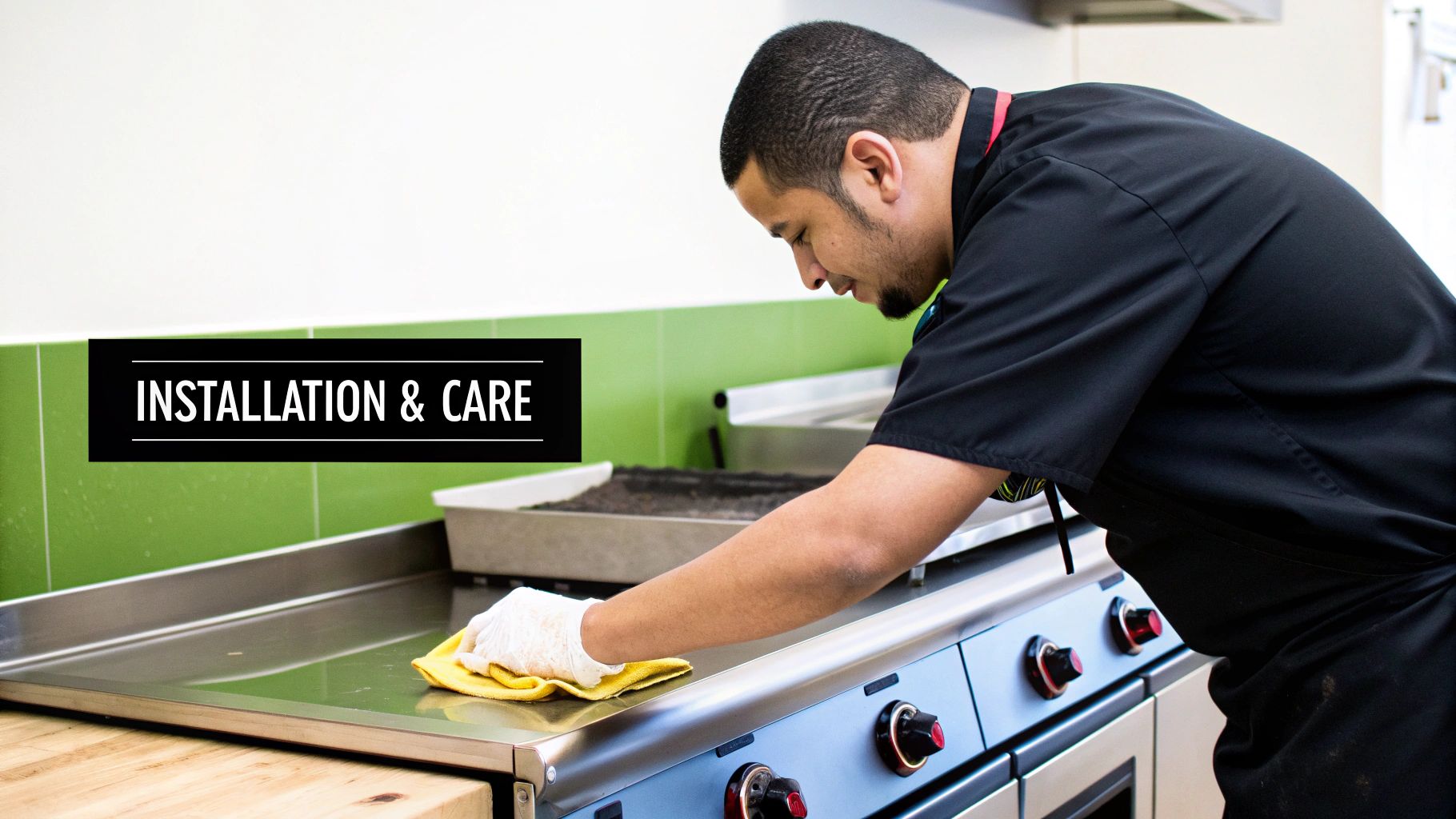
The Ultimate Guide to Commercial Griddles for Your Business
Walk into any busy professional kitchen, and you’ll see it—the commercial griddle, fired up and running hard. It’s not just another piece of stainless steel; it's the engine powering the breakfast rush and the star player during lunch service. This guide is all about why picking the right commercial griddle is one of the most important decisions you'll make for your restaurant, cafe, or food truck.
The Unsung Hero of Your Commercial Kitchen

A commercial griddle is the ultimate kitchen workhorse. It’s a flat-top beast that can juggle a massive, diverse menu with both speed and consistency. From flipping stacks of pancakes in the morning to searing off beautiful steaks at night, its huge, evenly heated surface lets chefs crank out orders when the tickets are piling up. In many ways, this one appliance can make or break your kitchen's efficiency and the quality of your food.
But getting the right one isn't as simple as picking the biggest one you can find. You have to really think about what your kitchen actually needs. The commercial appliance world is always changing, and griddles are no exception. Just look at the broader market: the global demand for reliable commercial appliances was worth about $886 million in 2024 and is expected to keep climbing as businesses look for convenient, high-tech solutions. You can discover more trends in the commercial appliance market here. It shows that smart owners are investing in specialized gear that works reliably, day in and day out.
More Than Just a Flat Surface
Don't just see a commercial griddle as a hot plate. Think of it as the central command of your cooking line. The right griddle affects everything, from how fast food gets to the window to the final quality of the dish.
Here's what a good one brings to the table:
- Menu Versatility: You can cook almost anything at the same time—delicate eggs on one side, hefty burgers on the other—without juggling a dozen pans.
- Consistent Results: Good thermostatic controls hold the temperature steady across the whole surface. That means every single pancake, hash brown, or steak is cooked just right.
- High-Volume Output: A big griddle surface means you can serve more people, faster. During a rush, that's money in the bank.
A well-chosen griddle is an investment in workflow. It reduces clutter on the line, simplifies the cooking process for your staff, and delivers the consistent product your customers expect every time they order.
Nailing these basics is the first step. The real goal is to find a machine that perfectly matches your menu and your volume, turning it into a genuine asset for your business. And remember, outfitting your entire kitchen line correctly is key. Once you've got your cooking station planned, explore our guide on selecting the right back bar cooler to complete your service area. Now, let’s get into what you need to know to find the perfect griddle for your operation.
How a Commercial Griddle Actually Works
Think of a commercial griddle as a simple but powerful machine designed for one thing: transferring heat. Its whole job is to take energy from either a gas burner or an electric element and spread it evenly across that big, flat cooking surface. In the kitchen, we call this a "heat blanket"—a totally predictable and consistent surface that's a must-have for any high-volume operation.
That even heat isn’t just luck. Underneath the griddle plate, the heating elements are laid out specifically to get rid of any hot or cold spots. This is how you guarantee that a burger on the corner cooks just as fast as the one in the middle, which is crucial for quality control when the tickets are flying in.
The Role of Thermostats and Heat Zones
The real secret to a griddle’s consistency is its thermostat. Picture the thermostat as an energy traffic cop. You dial in your target temperature—let's say 350°F—and it constantly monitors the plate. The second you drop some cold food on there and the temperature dips, the thermostat tells the heating elements to fire up and push more energy to the plate, holding that perfect 350°F.
This back-and-forth communication is what gives you predictable results and stops food from getting burnt or coming out undercooked. Fancier griddles even have multiple heating zones, each with its own thermostat. This setup lets a chef sear steaks at high heat on one side while gently warming buns at a lower temp on the other, all at the same time.
A griddle without a good thermostat is just a hot slab of metal. It’s the ability to hold a precise temperature under pressure that makes it a true professional tool. A dependable piece of kitchen equipment works on a similar idea, using thermostats to ensure perfect results every single time.
Why Plate Thickness and Material Matter
The griddle plate itself is a huge part of the equation, especially when it comes to heat management. The two biggest factors are how thick it is and what it’s made of. A thicker plate is like a heat battery; it takes a bit longer to get hot, but once it's up to temp, it holds onto that heat like a champ.
This quality is called heat retention, and it's what determines your recovery time. If you slap a dozen frozen patties on a thin griddle plate, the temperature will plummet, and your cooking will grind to a halt. A thick plate, on the other hand, has so much thermal energy stored up that it bounces back almost instantly, keeping the line moving without a hitch. This infographic really shows the difference thickness makes.

As you can see, a thick plate holds its temperature for nearly three times as long. That stability is what separates a light-duty griddle from a workhorse built to survive a relentless dinner service.
Matching Griddle Plate Type to Your Menu

The griddle plate is where the magic happens. It’s the surface where your menu comes to life, and the material you choose has a massive impact on how your food cooks, looks, and tastes. This isn't just a small detail—it's a core decision that needs to line up perfectly with what you’re serving day in and day out.
Think of it like this: a chef wouldn't use a delicate non-stick pan for a high-temp steak sear. The same logic applies here. Just as a modern piece of kitchen equipment is built for a specific kind of output, your griddle plate needs to match your kitchen’s rhythm. The wrong choice leads to food sticking, frustratingly slow recovery times between orders, and inconsistent results that will have your cooks pulling their hair out.
Let’s dig into the most common plate materials to find the right fit for your operation.
The griddle plate you choose is one of the most important decisions you'll make for your line. It dictates everything from cooking performance and flavor transfer to cleanup procedures. Below is a quick comparison to help you match the right material to your menu.
Comparing Commercial Griddle Plate Materials
| Plate Type | Key Characteristics | Best For | Kitchen Examples |
|---|---|---|---|
| Standard Steel | Durable, excellent heat retention, requires seasoning. The classic workhorse. | High-fat, high-sear items like burgers, bacon, and cheesesteaks. | Diners, burger joints, food trucks. |
| Polished Steel | Smoother surface than standard steel, easier to clean, less sticking. A versatile middle ground. | All-purpose cooking; kitchens with diverse menus from breakfast to dinner. | Family restaurants, cafes, institutional kitchens. |
| Chrome | Superior non-stick surface, prevents flavor transfer, radiates less heat. The premium option. | Delicate items like eggs, pancakes, fish, and vegetables. | Breakfast spots, seafood restaurants, hotels. |
Each material has its place. The key is understanding what you cook most and picking the tool designed for that job to ensure your kitchen runs smoothly and your food comes out perfect every time.
The Workhorse: Standard Steel
Standard steel griddle plates are the industry standard for a reason. They're affordable, tough as nails, and absolute beasts when it comes to holding high, even heat. This makes them perfect for getting that fantastic crust and deep sear on meats.
This is your go-to plate for classic diner food. Once you season it properly, the porous surface builds up a natural non-stick layer that also adds a subtle, unique flavor to everything you cook.
- Best For: Burgers, cheesesteaks, bacon, and other fatty items that need a serious sear.
- Keep in Mind: It needs consistent seasoning to keep rust away and maintain that non-stick finish.
The Upgrade: Polished Steel
Polished steel is a nice step up from the standard plate. The surface is smoothed out, which cuts down on food sticking and makes the end-of-night cleanup a whole lot easier. You get the same great heat retention as standard steel but with a cleaner cooking experience right out of the box.
This surface is a fantastic middle-ground option, giving you the raw heating power of steel with a little more finesse. It's an excellent choice for kitchens that are flipping everything from pancakes to patties and need a versatile surface that can keep up.
The real value of a griddle plate is how well it transfers heat and releases food. The right material means less food waste from sticking and less time spent scraping, which goes straight to your bottom line.
The Premium Choice: Chrome
If your kitchen focuses on delicate items, a chrome-plated griddle is the top of the line. Chrome is incredibly non-stick, letting you cook things like eggs, fish, and pancakes with almost no oil. It also stops flavor transfer in its tracks, so your pancakes won't taste like the onions you just sautéed.
But the benefits don't stop at performance. Chrome is also highly efficient, radiating far less heat into your kitchen. That can lead to lower energy bills and a much more comfortable environment for your staff. While it costs more upfront, for the right menu, the performance and ease of use are impossible to beat.
Essential Features and Sizing Your Griddle
When you’re picking out a commercial griddle, it really boils down to two things: getting the size right and choosing the features that actually fit how your kitchen runs. Nail these two, and you've got a workhorse. Mess them up, and you've bought a very expensive mistake that's either too small for the rush or too big for your space.
Let’s talk size first. A griddle that's too small is an instant bottleneck on the line. It slows down ticket times and drives your cooks crazy. On the flip side, a griddle that's way too big is just burning through energy and hogging valuable kitchen real estate. To find that sweet spot, you need to do a little math on your peak hour.
For example, if you're slinging 50 burgers during your busiest lunch rush and each one takes up about 6 inches of space, you'll need at least a 36-inch griddle just to keep up. My advice? Always pad that number by 20-30% to handle those unexpected surges.
The goal is to buy a griddle that can comfortably handle your busiest hour without being completely maxed out. This foresight prevents service delays and ensures consistent food quality when it matters most.
Controls and Power Source
Once you've got the size figured out, it's time to think about controls and power. This choice hits everything from cooking precision and your utility bills to how easy (or hard) the installation will be. You’re looking at two main options for controls: manual or thermostatic.
- Manual Controls are your basic low, medium, and high settings. They're not super precise, but they're affordable and get the job done for simple, high-heat tasks like searing steaks.
- Thermostatic Controls are for precision. You can set an exact temperature, say 350°F, and the griddle cycles on and off to hold it there. This gives you way more consistency, which is perfect for delicate stuff like eggs and pancakes.
The other big decision is gas versus electric. Gas griddles usually heat up faster and can have lower operating costs, which is why you see them in so many high-volume kitchens. Electric models, though, often give you more even, precise heat across the whole surface and are a lifesaver if you don't have a gas line ready to go. It really comes down to your kitchen's setup and whether your menu needs fast heat recovery or pinpoint accuracy.
The demand for solid, specialized kitchen gear is growing everywhere. Take the commercial equipment market—it was valued at $3,894 million in 2025 and is expected to grow at a 6.1% clip every year through 2033. This just shows how much restaurants and hotels rely on high-performance equipment to keep things running smoothly. You can discover more insights about commercial appliance market trends and see how this thinking applies to any major kitchen investment.
A dependable griddle is a cornerstone of a well-run kitchen. If you're also looking to outfit your beverage stations, you can explore our collection of high-quality ice makers to round out your equipment lineup.
Installation and Maintenance Best Practices

A top-tier commercial griddle is only as good as its setup and upkeep. The real secret to unlocking its full potential, keeping your kitchen safe, and making it last for years is simple: proper installation and a rock-solid daily maintenance routine. Skipping these steps is a recipe for poor performance, safety risks, and expensive repair bills down the line.
Getting the installation right from the get-go is non-negotiable. This isn’t a weekend DIY job; professional installation is absolutely critical for safety and performance. A pro will make sure every connection is secure and that your setup is fully compliant with local fire and safety codes.
Key Installation Checks
Before you even think about firing up that griddle for its first service, a few key things need to be squared away. Proper ventilation is probably at the top of the list, as it has a direct impact on your kitchen's air quality and your staff's well-being.
- Ventilation and Hood Compatibility: Your griddle needs to live under a commercial-grade ventilation hood. This is essential for pulling heat, smoke, and grease-filled air out of the kitchen.
- Clearance Codes: Every griddle has its own "personal space" requirements. You must follow the manufacturer's specified clearance distances from walls and other equipment to prevent a serious fire hazard.
- Utility Connections: Whether it’s gas or electric, leave the hookups to a licensed professional. A bad gas connection can lead to dangerous leaks, and faulty wiring is one of the quickest ways to start a fire.
Proper installation isn’t just about ticking boxes on a checklist; it's about building a safe and efficient cooking environment. A correctly installed griddle runs better, is safer, and lays the groundwork for years of dependable service.
Creating a Daily Maintenance Ritual
Once your griddle is professionally installed, its lifespan is in your hands. A consistent cleaning routine is the difference between a workhorse and a headache. It prevents flavors from mingling, stops dangerous grease from building up, and keeps your cooking surface in perfect shape. After all, a clean griddle heats more evenly and makes food taste better.
A simple, step-by-step cleaning process at the end of every single day will make a world of difference. This daily ritual is the single best thing you can do to protect your investment and ensure you're always serving safe, high-quality food.
To help you build a solid routine, we've put together a comprehensive guide on commercial kitchen equipment maintenance that covers best practices for all your essential appliances.
Here’s what that daily clean-up looks like:
- Scrape While Warm: After the last order is out and while the griddle is still warm (but not blazing hot!), use a griddle scraper to get all the food bits and grease off.
- Degrease the Surface: Apply a food-safe griddle cleaner or degreaser and give it a good scrub with a griddle pad or brick to break down any stubborn, cooked-on residue.
- Rinse and Dry: Wipe the surface with a damp cloth to get rid of any cleaning solution, then dry it completely. This is key to preventing rust.
- Re-season (for Steel Plates): If you have a standard or polished steel griddle, finish by applying a very thin layer of cooking oil to the clean, dry surface. This protects it and helps maintain that non-stick quality.
Common Commercial Griddle Questions
When you're looking to buy, operate, or maintain a commercial griddle, questions are bound to come up. It's a major piece of equipment, and getting the right answers is the key to making a smart investment and keeping your kitchen humming. Let's tackle some of the most common things we hear from business owners.
First up, "How often do I really need to clean this thing?" You absolutely have to scrape it clean after every single use to get rid of food bits. At the end of every day, it needs a more thorough cleaning with a griddle brick and a good degreaser to stop that nasty carbon from building up. For most steel plates, a weekly deep clean and re-seasoning is the sweet spot.
Key Operational Differences
Another big question we get is about the controls. What’s the real story behind a manual versus a thermostatic griddle?
- Manual Griddles: Think of these as having simple low, medium, and high settings. They don't offer exact temperature control, but they're often cheaper and perfect for kitchens that just need to crank out simple, high-heat items.
- Thermostatic Griddles: These are all about precision. You can set an exact temperature and trust it to stay there. This level of consistency is a game-changer for delicate items like eggs, pancakes, or seafood where the right heat is everything.
And finally, the age-old debate: gas or electric? Gas griddles are the sprinters—they heat up faster and usually come with lower utility bills, making them a favorite in high-volume kitchens. Electric griddles, on the other hand, tend to provide more even, consistent heat across the entire surface and are a lifesaver when you don't have a gas line available.
Ready to find the perfect griddle for your kitchen? Explore our full collection of high-performance commercial griddles at Griddles.com and get equipped with a workhorse built for the daily grind. Visit us now at https://griddles.com to find the right fit for your business.
